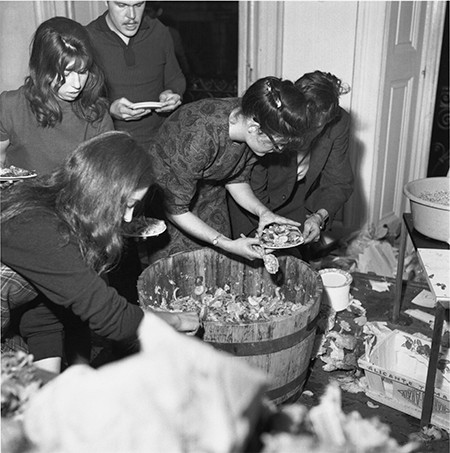Writing in Something Else Newsletter in 1966, Fluxus artist Dick Higgins (1938–1998) aptly summarized the postwar era’s spirit of artistic reinvention by coining the term “intermedia” to describe the emergence of hybrid forms: happenings, minimalist music, avant-garde film, multimedia performance, video art, and so on. Fluxus was an itinerant and loosely knit group of international artists, writers, performers, and composers who came together in New York City and Western Europe in the early 1960s out of a shared desire to erode the boundaries separating artistic disciplines. The name Fluxus, derived from the Latin for “flow,” was chosen for its breadth of meaning and linguistic flexibility. The group formally coalesced in 1962 when George Maciunas (1931–1978), a Lithuanian-born artist, invited several artist friends to travel from New York City to Wiesbaden, Germany, to perform in the “newest music festivals”—largely characterized by minimally scripted performance scores for action (shaving a head, destroying a piano, reading out printer receipts at various intervals, making a salad). These unusual proposals were derived from experimental musical notation modeled on that of American composer John Cage (1912–1992). One of Cage’s close collaborators was a founding member of Fluxus, the American artist Alison Knowles (b. 1933), who transitioned from an early career in abstract expressionist painting to a lifelong embrace of performance art predicated on an interpretation of Cagean theories of chance and indeterminacy. Directly stimulated by Cage’s deployment of words (instead of numbers or graphs) to compose musical scores in the late 1950s, Knowles would create innovative scores designed for studio painting—including tossing a pair of dice according to number charts in the I Ching to resolve shape and color arrangements on large-scale canvases. A rigorous adoption of chance as a method for composition offered Knowles a nominal emancipation from her own willful choices, even her own subjectivity. An embrace of indeterminate outcomes permitted her to move effectively into a more contingent, depersonalized space of aesthetic possibilities.
It was under the auspices of the Festival of Misfits in London, for example, that Knowles premiered her now famous Fluxus score, Proposition #2: Make a Salad (1962). Briefly, Knowles composed a salad for the audience with foodstuffs collected throughout the day in a large pickle barrel found in a local market. She did not offer a recipe for the salad, nor did she indicate its specific form or ingredients; rather, she provided a template that merely required an action to be completed. Her deliberately open proposition became a consciously artistic, even musical, staging as the sounds produced in the gesture of slicing vegetables subtly inferred sonic movements and served to undermine certain expectations of viewing. Which is to say, Knowles refused to produce what an audience might reasonably require—a discrete art object whose primary aim is subjective contemplation—and instead performed a living-art event, the aim of which was categorically more provocative. In fact, the artist’s choice of actions and materials was no innocent gesture. With its invocation of domestic service (shopping for the salad, preparing the salad, sharing the salad), Knowles elevated an accepted fact of living for aesthetic consideration and signaled a desire to address the implications of gender, ritual, and the routinized performances one labors through every day.
The cultural and practical conditions for the emergence of Fluxus and Knowles’s role within it form the first two chapters of my book, “Performing Chance: The Art of Alison Knowles In/Out of Fluxus.” The first scholarly monograph on Knowles, the book, organized into five chapters, provides close formal and historical readings of key works made from the late 1950s to the early 1980s. Despite the deliberate lightness and humor evident in much of her practice, I argue that Knowles’s Fluxus scores and performances occasion a deeply serious engagement with her audiences—an ethics of generosity, even—grounded by a fierce commitment to the labor of creative expression premised on a denial of mastery and ego. In the remaining three chapters, I consider a specific set of projects created by Knowles that were informed by her expanded investigations of chance, the body, and the everyday. I look at her readymade objects (Bean Rolls, 1963); her performances based on her life as a working artist and mother (The Identical Lunch, 1969–1975); and her groundbreaking works in digital poetry, acoustical art, and large-scale installations (The Big Book, 1967; The House of Dust, 1969; Gentle Surprises for the Ear, 1973; The Book of Bean, 1983). The book also situates Knowles within the discursive apparatus of earth art projects of the era, comparing her work, for the first time in the historical literature, with the built environments of, for example, Mary Miss and Alice Aycock. Broadly speaking, the book expands our understanding of the post–World War II cultural landscape by analyzing the rapid proliferation of indeterminate outcomes as a viable mode for interdisciplinarity—not simply and uncritically aping the aleatory activities of Cage, as is often the charge against Fluxus artists, but rather through a protofeminist dialectic of chance. Ultimately, I conclude that as a method of art-making, Knowles advanced an understanding of chance as no arbitrary formulation but rather a politics, a structure, and a stake in the reception and distribution of art’s meaning.
During my residency at CASVA, the manuscript was significantly broadened and deepened by late-stage writing and archival research. In addition to the exceptionally rich materials in the National Gallery of Art Library, including a remarkable collection of Fluxus books and vertical files, I was able to closely examine Something Else Press artists’ pamphlets, a large folio of prints by John Cage, and rare pieces of concrete poetry. I also greatly benefited from regular access to the Archives of American Art at the Smithsonian Institution, which holds Fluxus files and ephemera; the Dick Higgins Papers, 1958–1997; and transcripts of oral histories of key Fluxus artists, including Knowles.
